Momentum transfer at the air-sea interface
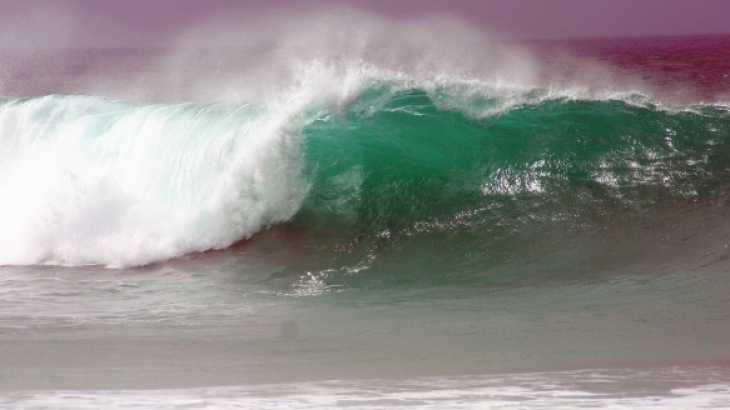
Waves at the beach - a common known result of air-sea-interaction. -image: Hereon-
The exchanges of momentum and scalars across the ocean interface strongly influence climate, ocean circulation, and the development of storms, especially in coastal waters.
In this respect, the role of surface waves, their influence on the near surface airflow dynamics as well as wave current interaction are of importance. However, our physical understanding in particular, with respect to their coupling and at higher wind speeds remains incomplete.
To better quantify and understand their interactions, several measurement techniques for high-resolution remote sensing of near-surface wind, current, and wave fields were developed. The methods are based on radars, lasers, and video cameras, covering scales between millimeters and hundreds of kilometers:
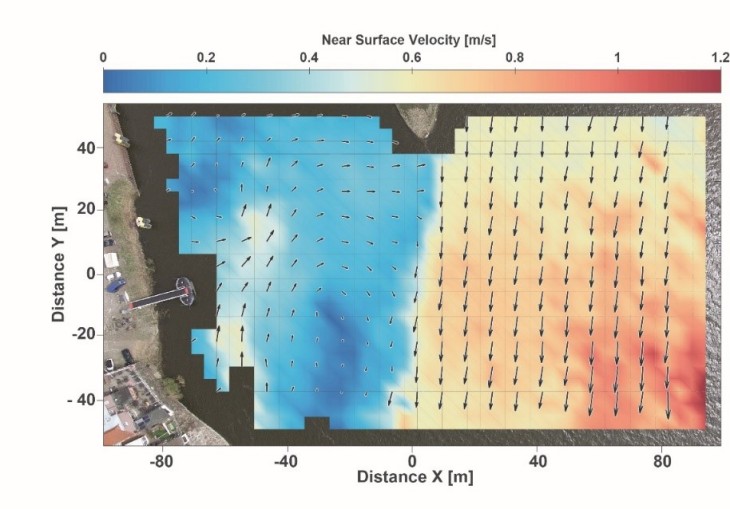
Surface current field in the Elbe River at Lauenburg retrieved with a quadcopter drone. -image: Radar Hydrography / Hereon-
Small-scale physical processes in the ocean are often characterized by sharp fronts that have strong horizontal shear.
In order to sufficiently resolve these processes in space (a couple of meters) and time (minutes), the techniques developed for marine radar image sequences were adjusted to the needs of video sequences of water surface waves. Video sequences were acquired in the range of visible light with a small, nadir-looking video camera attached to an off-the-shelf quadcopter drone.
The video data acquired by the gimbal stabilized video camera are geo coded and corrected for lens distortion. The resulting video data allow for measuring wave direction, wave length, and phase velocity.
These properties allow to measure surface current fields which result from the difference of the observed phase velocity and linear dispersion relation of surface waves.
See also the site of (url=https://ms.hereon.de/coptercurrents/index.php.en]CopterCurrents[/url].
Streßer, M., Carrasco, R., Horstmann, J., Video-Based Estimation of Surface Currents Using a Low-Cost Quadcopter, IEEE Geoscience and Remote Sensing Letters, 14, no. 99, 1-5, 2017, doi:10.1109/LGRS.2017.2749120
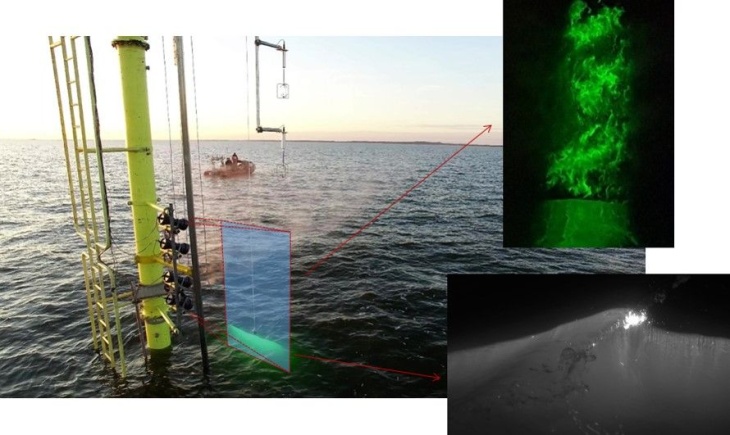
Image of in situ PIV experiment -image: Hereon-
A novel airflow measurement system was developed, capable of measuring millimeter-scale dynamics within the first meters above the ocean surface, using Particle Image Velocimetry.
See also the site of our Air-Sea-Fluxes group
Funke, C.S., Buckley, M.P., Schultze, L.K., Veron, F., Timmermans, M.E., & Carpenter, J.R. (2021): Pressure fields in the airflow over wind-generated surface waves. Journal of Physical Oceanography, doi:10.1175/JPO-D-20-0311.1
Yousefi, K., Veron, F., & Buckley, M. (2021). Turbulent and wave kinetic energy budgets in the airflow over wind-generated surface waves. Journal of Fluid Mechanics, 920, A33. doi:10.1017/jfm.2021.377
Buckley, M., Veron, F., & Yousefi, K. (2020): Surface viscous stress over wind-driven waves with intermittent airflow separation. Journal of Fluid Mechanics, 905, A31, doi:10.1017/jfm.2020.760
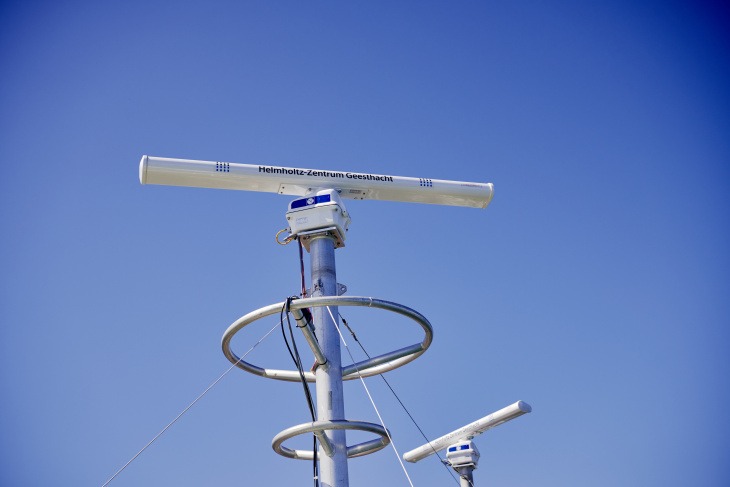
Marine Radar onboard Hereon's research vessel Ludwig Prandtl -image: Hereon-
In order to estimate the spatial variability of surface wave fields, to observe wave-current interaction, or wave energy dissipation, it is necessary to observe waves with sufficient spatial and temporal resolution over larger areas.
For this purpose, radar remote sensing techniques such as the coherent-on-receive marine radar with a range of up to 3 km were developed by this division Operational Systems. Utilizing the radar Doppler speed measurements, a robust method for retrieving significant wave heights was developed and validated. For the first time, it is now possible to retrieve significant wave heights from marine radars without any calibration and with a high accuracy of 0.21 m.
Hereon’s coherent-on-receive marine radar system is one of the most reliable systems available worldwide, and have therefore been used by several research partners in numerous campaigns in Germany, France, Norway, Taiwan, and the USA. They have been proven to measure surface wind, waves, currents, and bathymetry from moving vessels, fixed platforms, and coastal stations. The Hereon marine radar systems can now also be used
(i) as a Surface Feature Monitoring System (SuFMoS) for real-time observations of fronts, internal waves, wind gusts and sea ice,
(ii) for retrieving bathymetry in shallow water,
(iii) for retrieving surface winds and gusts, and
(iv) current measurements.
See also the site of our Radar Hydrography
Carrasco, R., Streßer, M., and Horstmann, J.: A simple method for retrieving significant wave height from Dopplerized X-band radar, Ocean Sci., 13, 95-103, 2017a, doi:10.5194/os-13-95-2017
Carrasco, R., Horstmann, J., Seemann, J.,Significant Wave Height Measured by Coherent X-Band Radar, IEEE Transactions on Geoscience and Remote Sensing, 55, no. 9, 5355-5365, 2017b, doi:10.1109/TGRS.2017.2706067
Horstmann, J., Nieto Borge, J.C., Seemann, J., Carrasco, R., Lund, B., Wind, Wave and Current retrieval utilizing X-Band Marine Radars, Chapter 16 in Coastal Ocean Observing Systems, 281-304, 2015b, doi:10.1016/B978-0-12-802022-7.00016-X
Huang, W.,Carrasco, R., Shen, C., Gill, E.W., Horstmann, J., Surface Current Measurements Using X-Band Marine Radar With Vertical Polarization, IEEE Transactions on Geoscience and Remote Sensing, 54, no. 5, 2988-2997, 2016. doi:10.1109/TGRS.2015.2509781
Lund, B., Haus, B.K., Horstmann, J., Graber, H.C., Carrasco, R., e, Near-Surface Current Mapping by Shipboard Marine X-nd Radar: A Validation, Journal of Atmospheric and Oceanic Technology, submitted 2017.
Støle-Hentschel, S., Seemann, J., Nieto Borge, J.C., Trulsen, K., Analyzing Coherent Spatio-Temporal Radar Measurements: Transfer Function and Sea Surface Reconstruction, J. Geophys. Res., submitted 2017
Vicen-Bueno, R., Horstmann, J., Terril, E., de Paolo, T., Dannenberg, J., Real-Time Ocean Wind Vector Retrieval from Marine Radar Image Sequences Acquired at Grazing Angle, J. Atmos. Oceanic Technol., 30, 127–139, 2013, doi:10.1175/JTECH-D-12-00027.1
Shen, C, Huang, W., Gill, E.W., Carrasco, R., Horstmann, J., An Algorithm for Surface Current Retrieval from X-band Marine Radar Images, Remote Sens., 7, 7753-7767, 2015 doi:10.3390/rs70607753
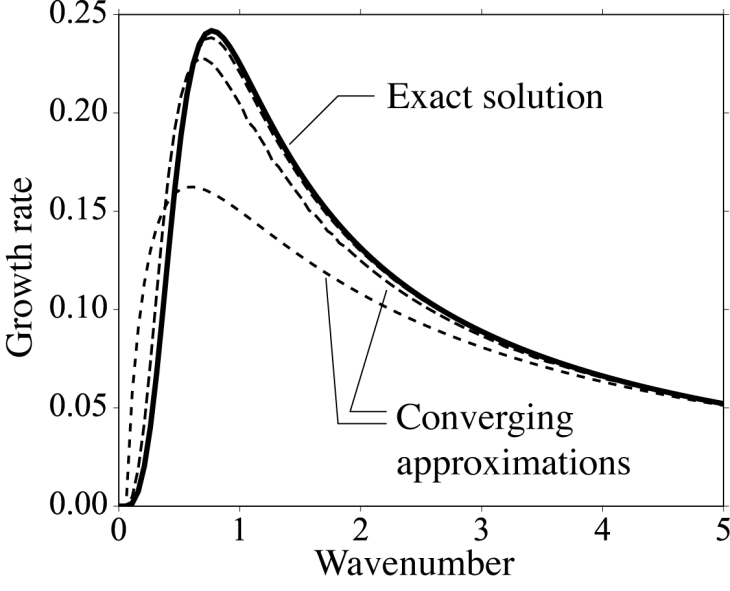
Plot showing the growth rate for the wind-wave instability for different wavenumbers (inverse wavelength). The dashed lines are a set of new approximations that quickly converge to the exact solution (solid line). -image:Hereon-
A key component of air-sea momentum transfer is in the growth of surface gravity waves from the airflow above. A new theoretical advance in understanding this process has been developed and a new physical interpretation of the wind-wave interaction instability is described.
This interpretation breaks the instability down into its simplest form, which consists of a two-way interaction between the surface wave and the airflow critical layer. It also links the physics of the wind-wave instability to those of stratified shear layers, such as the well-known Kelvin-Helmholtz instability.
This theoretical basis is also used for constructing an efficient solution method for computations of the most unstable modes likely to arise in different wind profiles.
See also the site of our Small-scale Physics and Turbulence group
Carpenter, J.R., A. Guha & E. Heifetz (2017): A physical interpretation of the wind-wave instability as interacting waves. Journal of Physical Oceanography, 47, 1441-1455, doi:10.1175/JPO-D-16-0206.1
